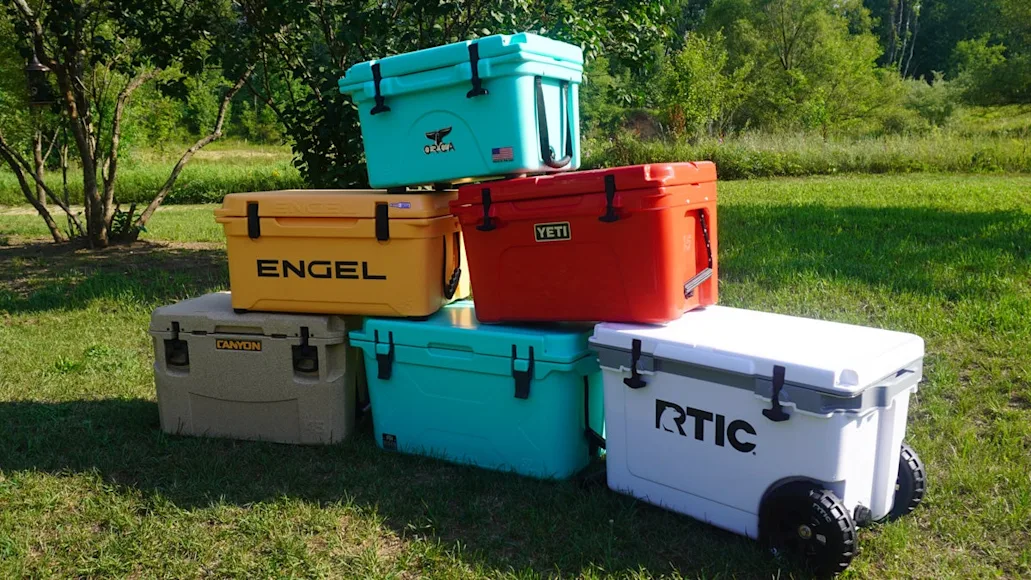We may earn revenue from the products available on this page and participate in affiliate programs. Learn more
Rotomolded coolers are very popular for outdoor enthusiasts, thanks to their rugged construction and extreme ice retention. Because they can stay cold for days in very hot temperatures, they make for some of the best coolers for camping, especially if you’re going far off the grid or plan on bringing along a lot of food and drinks.
The hard part is deciding on the perfect cooler for your outdoor adventures, whether you’re hunting, fishing, camping, or just heading to the beach. That’s why we took it upon ourselves to run six of the most popular options through a gamut of ice retention and durability tests. These are the best rotomolded coolers you can buy from brands like RTIC, Yeti, and Orca.
Best Overall: RTIC 52 QT Ultra-Light Wheeled Cooler
Best Lightweight: Yeti Tundra 45
Best Value: Canyon Pro 45
Best Insulated: Bison 50 QT
Best Budget: Engel 45
Most Portable: Orca 26 QT
Best Overall: RTIC 52 QT Ultra-Light Wheeled Cooler
Specs
Capacity: 78 cans (no ice)
Dimensions: 18” x 29”
Weight: 30 lbs
Extras: Bottle opener, wheels, aluminum pull handle
Pros
Surprisingly light
Easy to pull over rugged terrain
Convenient latches
Cons
Only a few color options
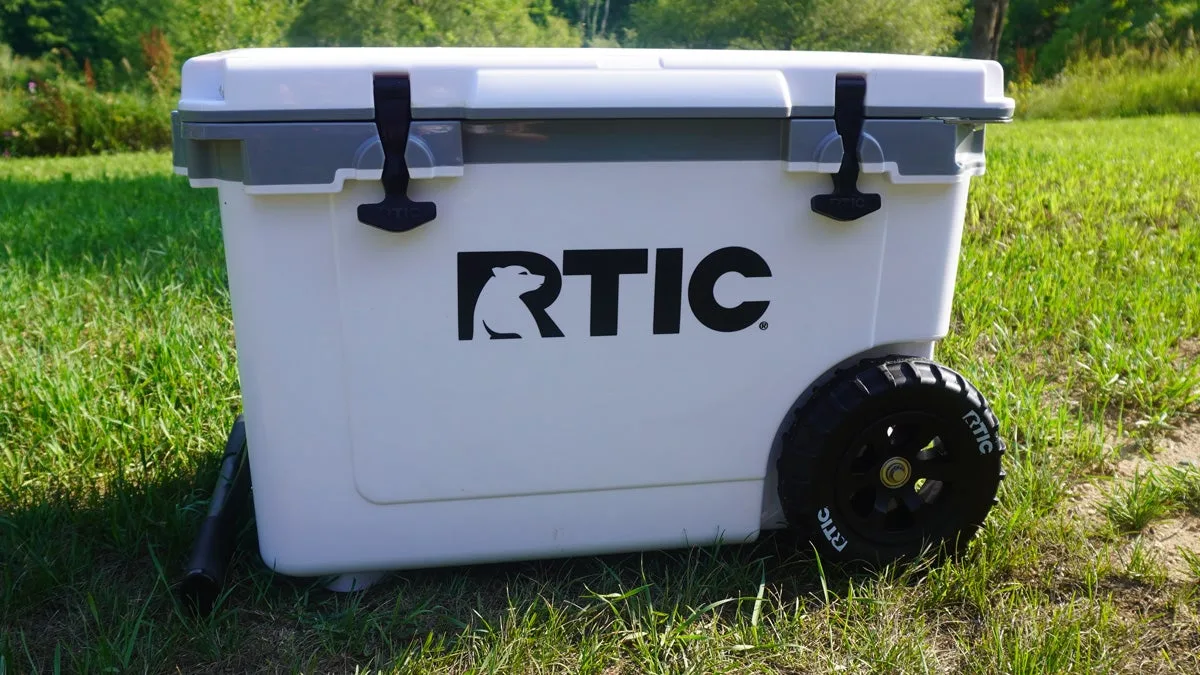
This 52-quart ultra-light wheeled cooler is a newer addition to the RTIC lineup that ended up impressing me at every turn. Large rotomolded coolers can get quite heavy, but the RTIC ultra-light comes in at a trim 30 pounds. How they managed to do that while outfitting the cooler with large wheels and a large handle to pull it, I’ll never know.
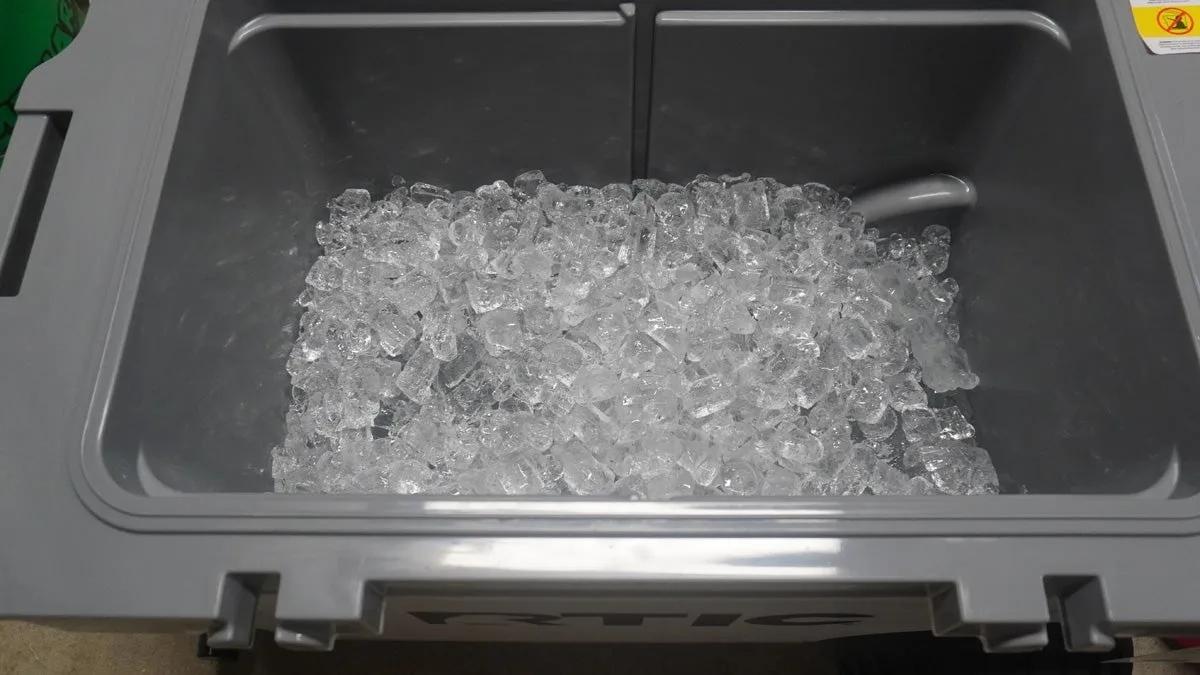
Even though it had the largest capacity of the tested coolers, it somehow wasn’t the heaviest. RTIC advertises this cooler as having a “no sweat exterior” that is supposed to remain dry with no mess. I found it did that as advertised. But I also noticed the cooler’s exterior stayed significantly cooler than the others I tested when in direct sunlight. It was a slight difference that was only noticeable when I put my hand on the cooler, but it was there. Some of that was probably due to the white color of my test model, but I can’t help but wonder if that feature is part of it, too.
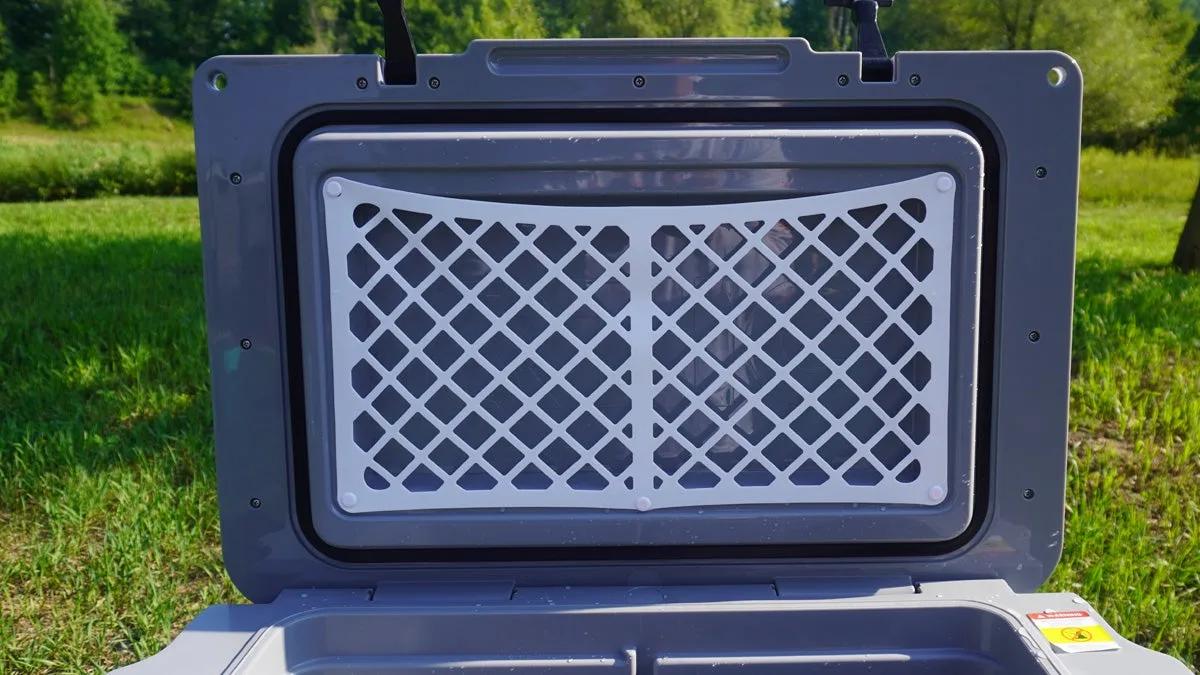
In terms of ice retention, this cooler was probably third best. Where it really won me over with the ease of its latches and the ergonomics of the pull handle. RTIC also offers this wheeled cooler at a very competitive price when compared to other wheeled options and they certainly didn’t skimp on the components. The wheels are extremely rugged, and rolled nicely over every terrain I toted the cooler across, including rocks and landscaping ledges in the yard. In the end, the mobility, durability, and price point stood out from the rest of the competitors.
Best Lightweight: Yeti Tundra 45
Specs
Capacity: 54 cans
Dimensions: 25.6” x 15.9” x 15.5”
Weight: 24 lbs
Extras: Wire tray
Pros
Lightweight
Looks great
Excellent ice retention
Cons
Price
Can scratch easily

The Yeti name needs no introduction in the world of coolers. While I was familiar with the brand, this was my first real experience with Yeti coolers. I wasn’t disappointed to find that they do in fact live up to the hype. This was the second-best cooler in terms of ice retention. It still had a little bit of ice on day six. It wasn’t a tremendous amount, but it was enough to show these things are very well designed. This cooler weighs a trim 24.6 pounds, which made a big difference every time I moved these things around. That light weight makes this my top pick for a fishing cooler because I think it’ll be easier to throw this in a boat or kayak than any of the other options here.
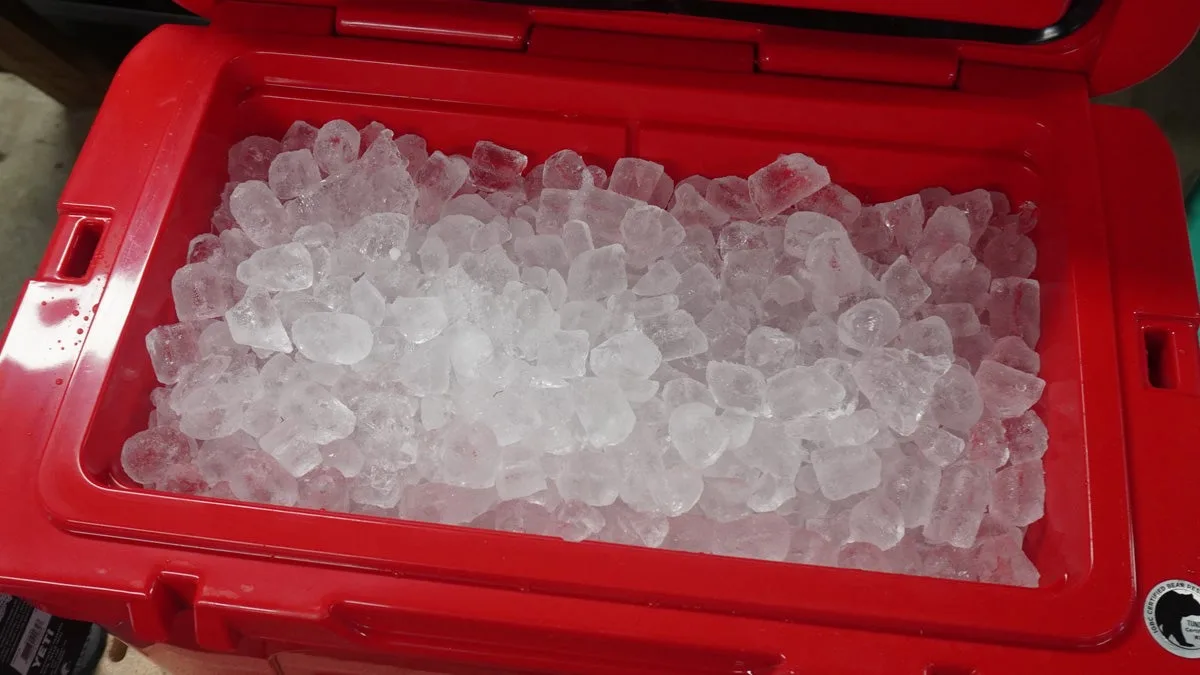
The Yeti Tundra has a much shinier finish than the others I tested. It gives the cooler a great look, but it also feels slightly less rugged than the others. You’ll probably worry about scratches. To my surprise, there were no permanent marks from the drop test. However, when I tossed a piece of firewood on the lid, it left a small, permanent scratch.
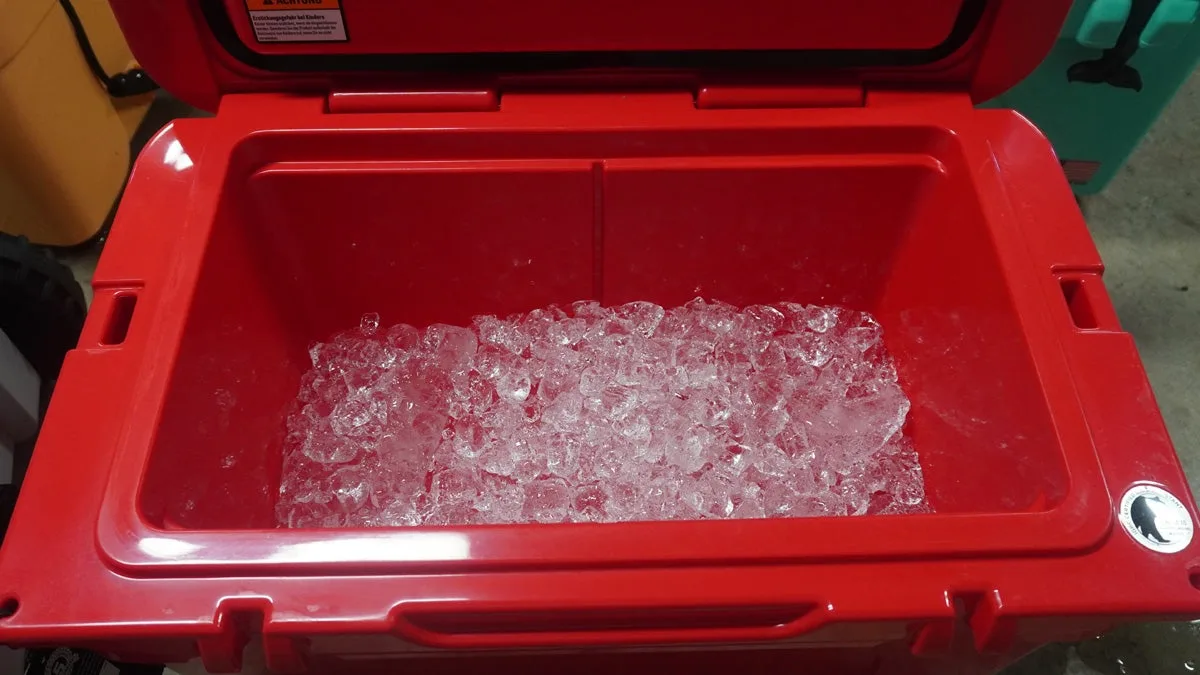
That’s not a make-or-break-it thing for me because I’m rough on my hunting, fishing, and camping gear anyway. With that said, I now understand why everyone is obsessed with Yeti, especially the Tundra, which our experts also dubbed the best ice chest. The latches are extremely ergonomic and easy to use. The rope handles also have very comfortable grips that make transporting this cooler from one place to another a snap.
Best Value: Canyon Pro 45
Specs
Capacity: 58 cans (no ice)
Dimensions: 26” x 17.25” x 16.25”
Weight: 38 lbs
Extras: Divider/table combo
Pros
Rugged construction doesn’t show scratches/dirt
Versatile table and divider
Great gasket seal
Cons
Latches take some getting used to
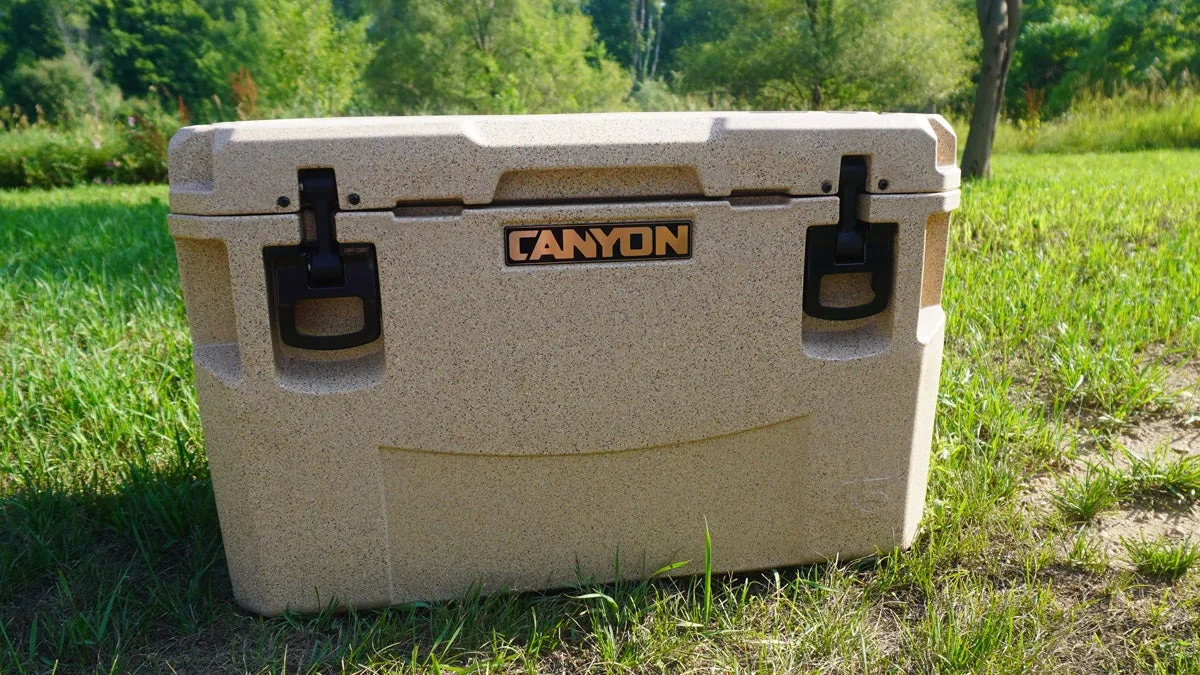
Canyon is more of a regional brand that’s popular in the western part of the U.S. I found the Canyon PRO to be an extremely versatile cooler that will work well just about anywhere. It has slightly thicker insulation than some of the others I tested along with a thicker gasket insulating seal. Additionally, Canyon also insulates the drain plug. The result is a cooler with excellent ice retention. It was still holding ice six days into the test.
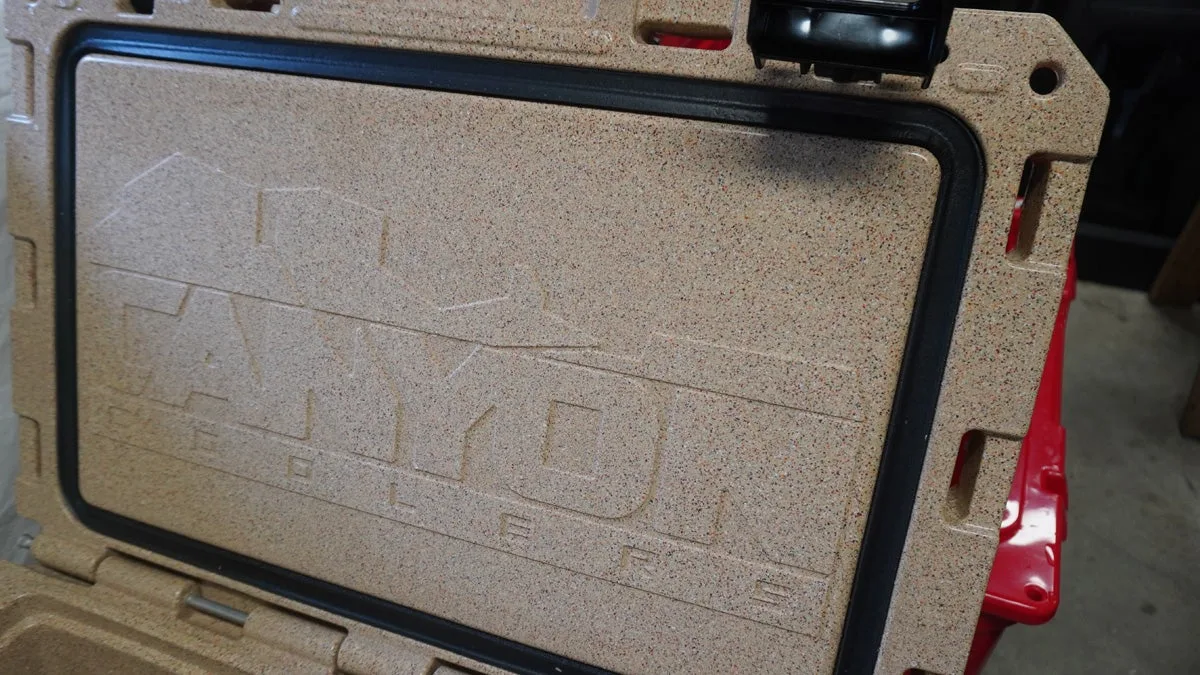
It’s easy to see why this is a popular choice of hunters in the west. Mainly because this cooler also did extremely well in my durability tests. The sandstone color of the model that I tested hid dirt well, and there were almost zero signs of the drops from the top of the ladder.
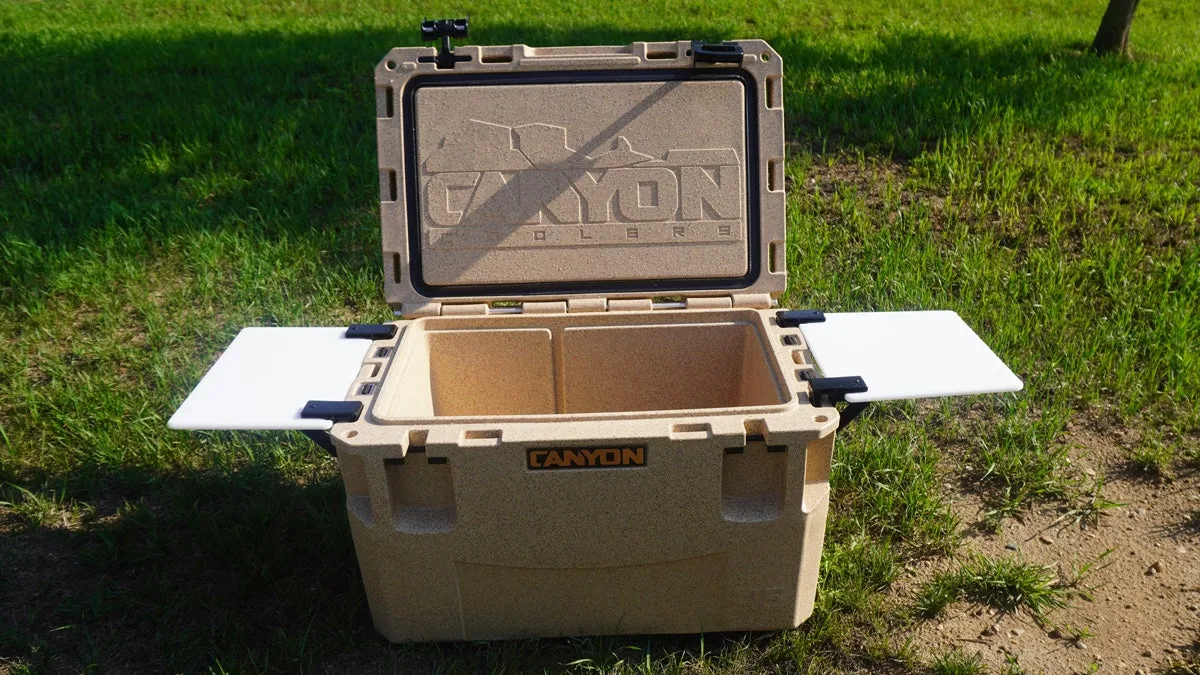
However, the real highlight—and why I picked this cooler for best value—is the genius design of the included divider. Brackets on the edge allow you to instantly transform it into a table, which fits perfectly into a series of notches around the perimeter of the lid. The table is rugged and food-safe, and would be perfect for cutting up and seasoning a fresh tenderloin after the hunt. Best of all, you can leave the table on the cooler while it is shut as the brackets are designed to fit within the lid without affecting the seal. Canyon sells extras of these divider/tables for additional organization and food prep space when you’re in the backcountry.
Best Insulated: Bison 50 QT
Specs
Capacity: 42 cans
Dimensions: 30.5” x 17.5” x 16.5”
Weight: 32 lbs
Extras: Tray, divider, and traction pad sold separately
Pros
Best ice retention we tested
Easy latches
Excellent gasket
Cons
Price
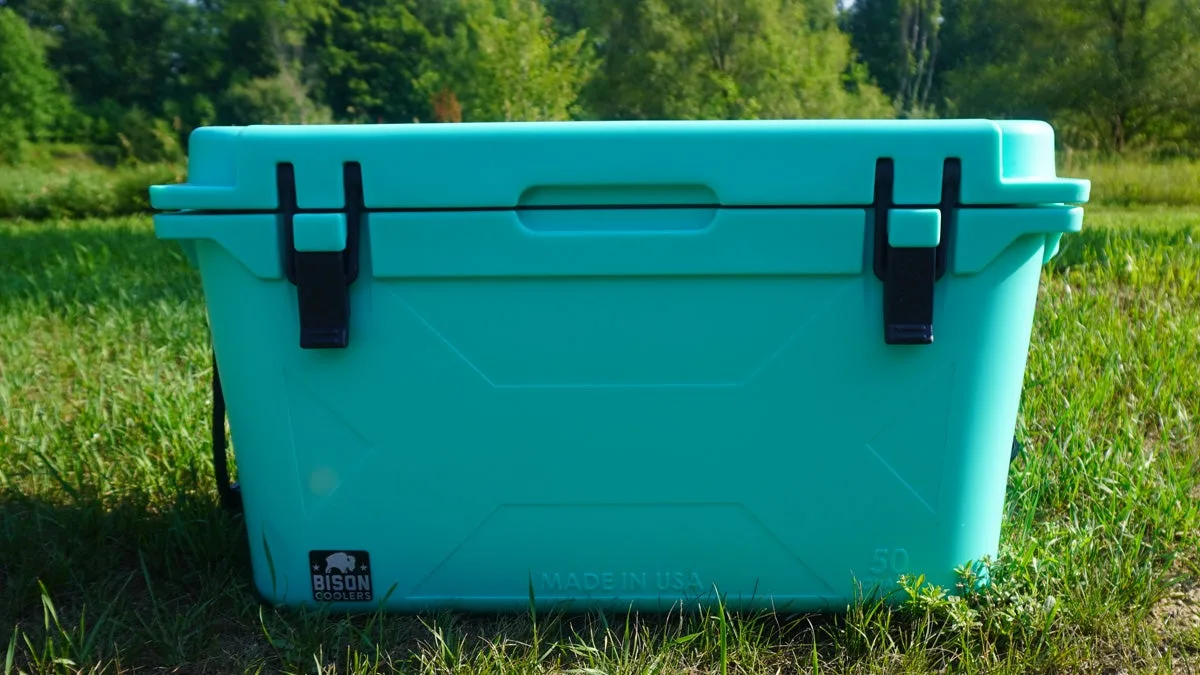
The Bison Seafoam is a perfect example of keeping things simple and to the point. There’s nothing super flashy about this cooler: thick walls and insulation, and a simple rubber latch. Yet it works like a charm. The Bison retained ice better than any other cooler in this test. The rest of the coolers had turned to water by day six or seven, but the Bison was still chugging along with a small pile of ice on day eight. This makes it a good choice for anyone who is planning a longer trip with fewer ice stops along the way.
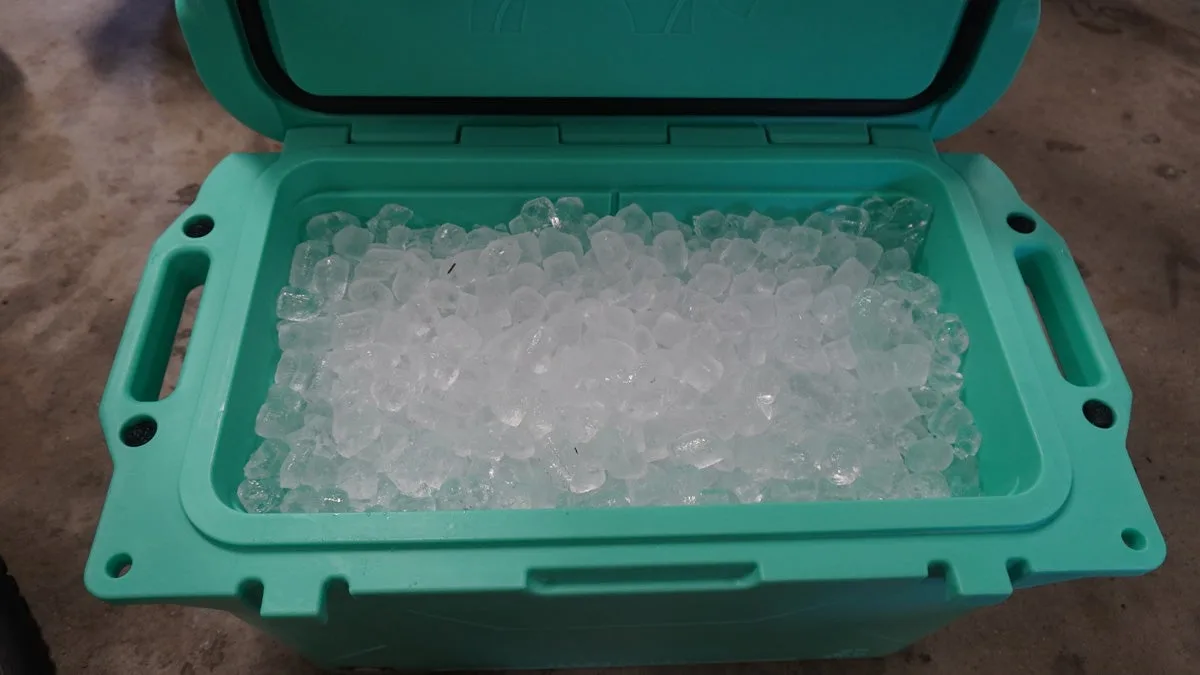
I want to highlight the latches on this cooler. They are very easy to operate and require almost no pressure to release and re-lock. This is notable because some of the coolers had latches that I suspect would be difficult for children or people with lingering hand injuries to open easily. That’s not the case with the Bison.

Additionally, the Bison easily handled all of the abuse I gave it. One of my drops landed directly on one of the corners and the cooler shrugged it off. The only real signs of abuse was some dirt on the outside, which can be washed off.
Best Budget: Engel 45
Specs
Capacity: 40 cans (2:1 ice ratio)
Dimensions: 27” x 18” x 14”
Weight: 26 lbs
Extras: Basket and divider sold separately
Pros
Simple, no-frills design
Very rugged in durability test
Good gasket
Cons
Latches can be stubborn at times

Coming in at $300, the Engel is one of the more affordable rotomolded coolers offered today. Like the Bison, this cooler has a simple, straightforward design that works exactly as advertised. The Engel did a nice job of retaining ice well into day five, and there was still some left on day six. It also took all the lumps I gave it during the durability test. It showed dirt a little more than some of the other coolers in the test, but it cleaned up quickly once I hit it with the garden hose.
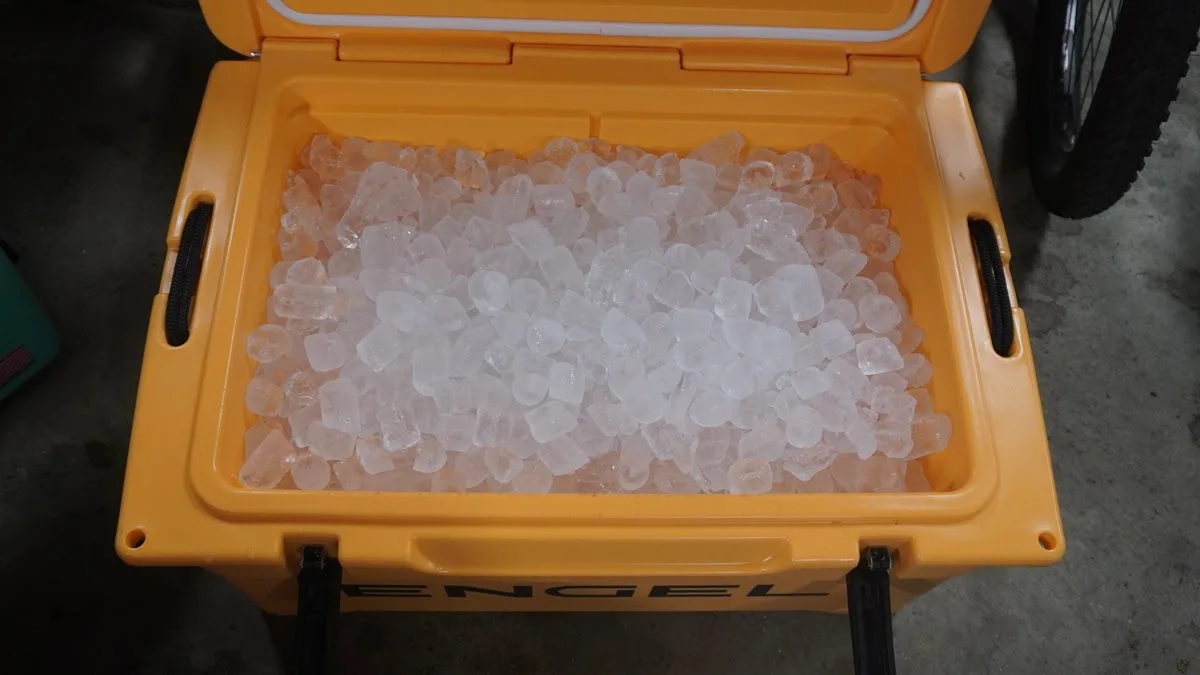
I only have one small gripe with the latches on this cooler. Sometimes they don’t latch quite right and require a second attempt. However, once they are latched, they are locked down and they won’t come open again until you need it open. One of my drops on the durability test landed squarely on the edge of the cooler. Another drop landed flat on the lid. Both times the cooler shrugged off the hard collision with the dirt.
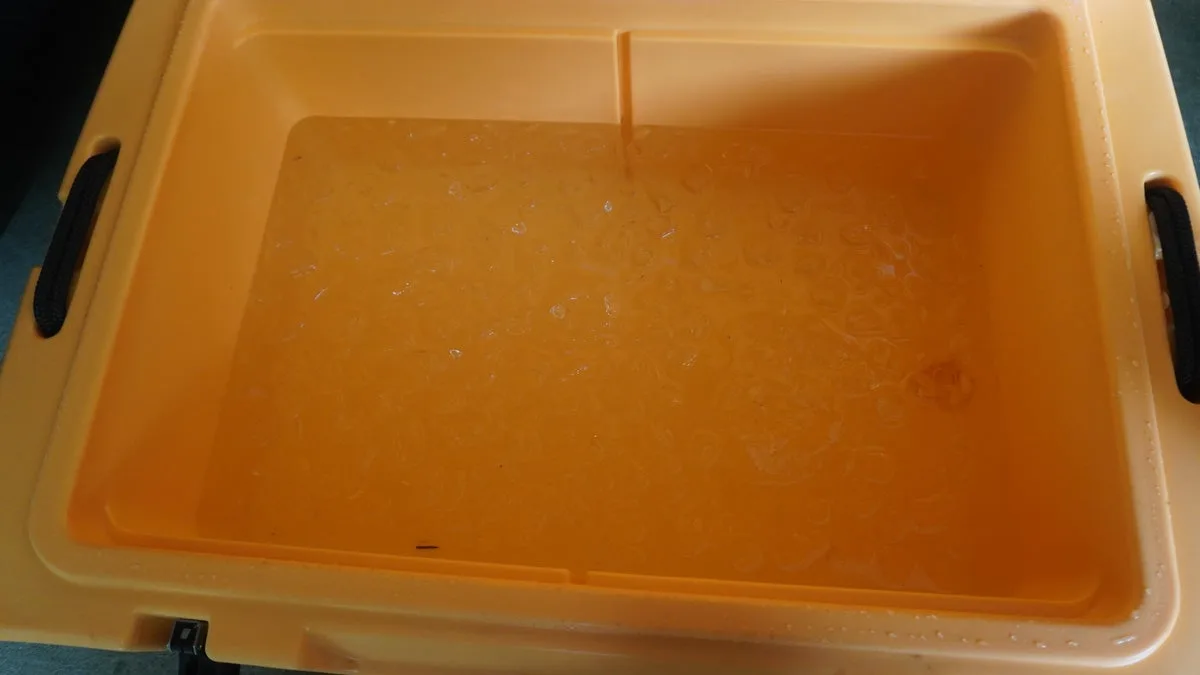
After the abuse I gave it, I can safely say it is durable and reliable. I also just like the mango yellow color. It’s a sharp color you rarely see on these styles of cooler.
Most Portable: Orca 26 QT
Specs
Capacity: 22 cans
Dimensions: 23.63” x 14.63” x 17.75”
Weight: 25 lbs
Extras: None
Pros
Comes in a variety of colors
Easy-to-use latches
Cargo net on back adds storage
Cons
Gasket works a little too well at times

The Orca is slightly smaller than the other coolers I tested, but this cooler held its own as far as ice retention and durability are concerned. The cooler has an excellent gasket that gives it a super airtight seal. In fact, that’s my only complaint about the cooler. There were a couple times where I needed to provide some extra elbow grease to get it open. Other than that, the cooler performed flawlessly. The Orca still had a decent amount of ice on day six of the retention test. It showed some blemishes and dirt after the durability tests, but it washed off rather quickly.
Another notable thing about this cooler is the excellent latches, which are ergonomic and easy to operate. They didn’t budge at all despite the cooler landing on its edges during a few of my drops. This cooler is perfect for a road trip because of the smaller footprint that makes it easy to put in a car trunk or the back of an SUV. Add in an affordable $275 price point, and it’s a winner all around.
How We Tested Rotomolded Coolers
For our hands-on testing, we first subjected all of the coolers to eight days of ice retention testing. For the ice retention tests, I bought enough ice to fill each cooler to the brim. For the six coolers tested, this amounted to 14 “big bags” weighing approximately 20 pounds apiece. That amounted to a little over $70 worth of ice! I bought 10 bags on the first trip, which elicited a baffled response from my local gas station cashier: “Do we even have that much ice?”
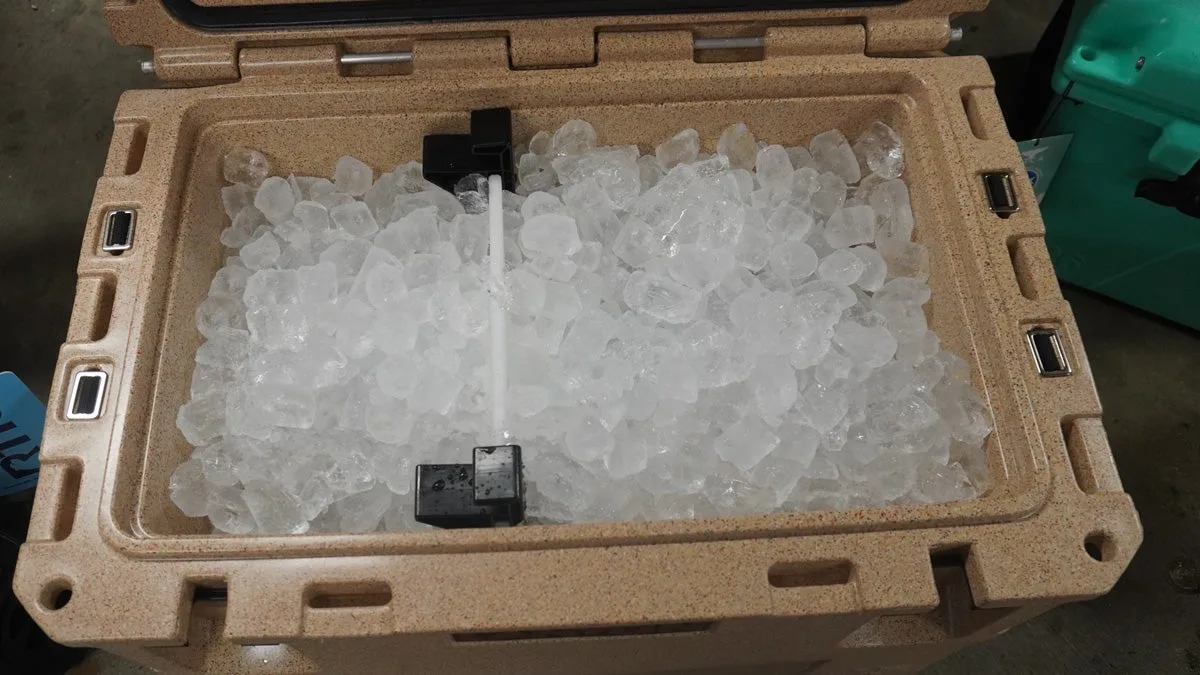
From there, I observed each cooler’s ice retention abilities over the course of the eight days. The coolers were shuffled around from my garage to direct sun in the yard. They spent two days in direct sunlight for approximately 12 hours a day, equating about 24 hours in total. The purpose here was to simulate a variety of different conditions in which they might be used.
Temperatures here in Michigan ranged from the mid 70s to the 90s during my ice test. I also want to note that this was done without pre-chilling the coolers, which is recommended by most major manufacturers. I also did not drain the water from melted ice from any of the coolers until the six days were up. Thus, the water helped to insulate the ice in each of the coolers to some degree.
Long story short, all the coolers were excellent in ice retention. Most were still holding ice four days into the test despite spending two of those days in direct sunlight. I’ll detail more on how each cooler performed more in each individual review, but it was almost a draw between all six coolers as far as retention goes.
Durability Test

Because testing individual wear and tear would be too time-consuming, I subjected the coolers to a series of durability tests as well. I dropped each cooler from the top of a 7.5-foot ladder in my yard not just once but three times. I made sure each cooler landed on an edge or side at least once. To test the abrasion resistance of the plastic, I chucked a big piece of firewood across the lid of each cooler and then observed the scratches made, if any.

I wasn’t gentle with any of the coolers at this stage of the test, and just threw them around when making room for other coolers to land. A few of them dinged into one another while I was doing this. I’m happy to report that other than some scratches, dings, and dents, all the coolers passed durability testing with flying colors.

In addition to the performance observed with each cooler, we also weighed the following factors in making our decisions:
Value: How does the price compare to the cooler’s ability to retain ice? Are you paying for the name more than the performance?
Aesthetics: Does the cooler look good? Is it available in a variety of colors to fit everyone’s tastes?
Accessories: Does the cooler come with organization trays? Cup holders? Small tables or other features? How much value do these add to the cooler?
What To Consider When Choosing a Rotomolded Cooler
Rotomolded coolers are an excellent choice for anyone who dislikes having to buy ice constantly. However, keep in mind that any cooler is going to see some melting eventually, especially if the cooler sits in the sun exposed to high temperatures. During my test, most of these coolers kept ice for five to six days while getting at least 24 hours of sunlight exposure (making them great boat coolers, as well). Most regular users won’t subject their cooler to conditions that tough. Thus, it’s fair to expect to get four to seven days of ice retention from most coolers out there.
Most manufacturers recommend not emptying the water from the cooler each day because it helps to insulate the ice and keep the cooler chilled longer. That means you’ll want to have some kind of container to keep food from falling into the water.
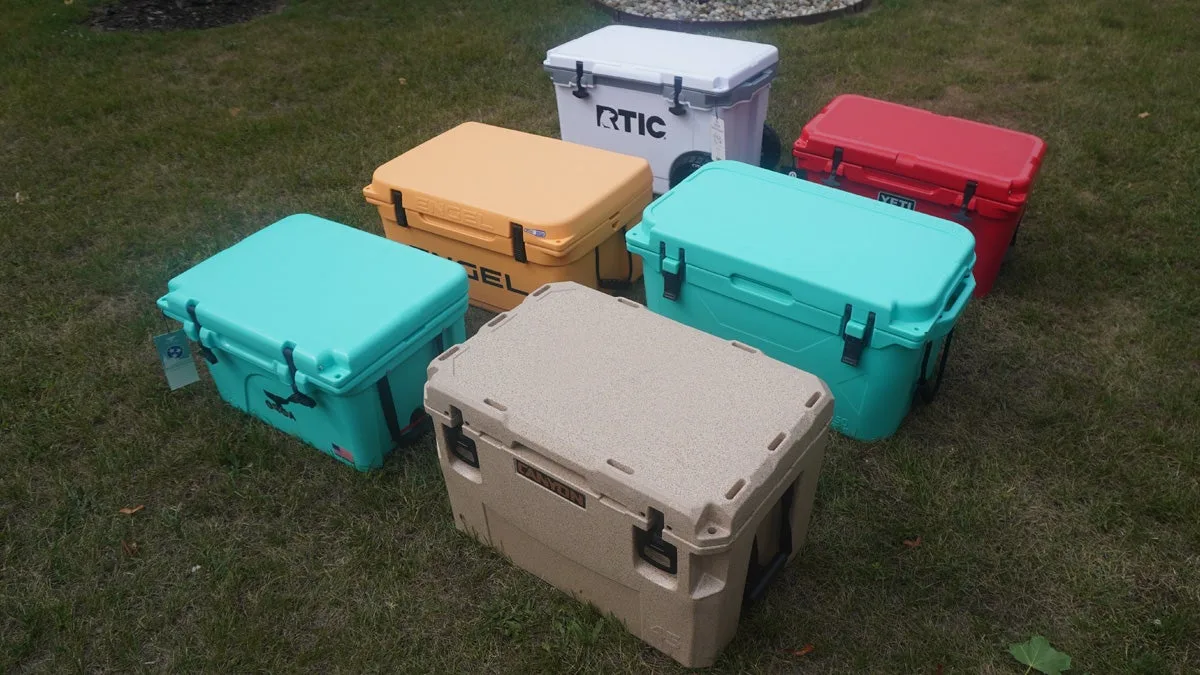
Cooler Weight
Rotomolded coolers are significantly heavier than other types of coolers. This is simply part of the design. The sidewalls of these coolers are thicker and they hold much more insulation inside. Add in a lot of ice and drinks, and some coolers take two people to move.
Weight may not seem like a huge issue until you go to empty the cooler at the end of a long trip and you’re tired from emptying out the car. It’s at those times that many people start regretting the weight of their cooler. If you are in the market for a larger cooler, it’s not a bad idea to look at a wheeled cooler simply for ease of transport.
FAQs
Q: What cooler holds ice the longest?
In my experience, rotomolded coolers hold ice longer than those constructed using other methods. And I’ve owned a lot of cheaper options. This is largely due to the improved insulation and thick wall construction that helps keep the heat out longer.
Q: What is a rotomolded cooler?
Rotational molding is a unique process that produces hollow plastic parts. Manufacturers then inject the interior with insulation. This produces extremely rugged coolers capable of withstanding a beating. They also retain ice better than other forms of hard-sided coolers. Rotomolding is a rather time-consuming process, and the cost of the materials is greater. Subsequently, these types of coolers have a higher price point.
Q: Do I need to clean my rotomolded cooler?
All coolers need to be cleaned periodically, especially if you are storing food in them for days at a time. Even if the ice does not melt completely, the cooler will start to develop a smell unless wiped down thoroughly. It is a good idea to use hot soapy water to clean your cooler. Most manufacturers of rotomolded coolers also recommend mixing baking soda with the soap and water to kill any lingering smells.
Q: How do I make my cooler keep ice longer?
There are several ways of keeping ice longer in a cooler. One is to leave melted water inside to insulate the remaining ice. Manufacturers also recommend pre-chilling your cooler either by adding ice before you intend to use it, or by storing it in a cool place ahead of time. Once your cooler is packed, avoid placing it in direct sunlight, and try to limit air exposure to the interior. Some companies, like Yeti, recommend using dry ice if possible because it keeps longer than standard ice.
Final Thoughts
Honestly, it’s hard to go wrong with any of the six coolers I tested for this piece. All proved quite rugged and durable, and all had excellent ice retention when compared to my non-rotomolded coolers. It’s difficult to single one out as best of the bunch in that department. All held ice for at least five days. It’s only because the Bison was the only cooler left with ice after eight days that it earned the best insulated title. At the end of the day the RTIC’s surprising weight combined with ease of transport was enough to win me over for the best overall cooler of the bunch.
Why Trust Us
For more than 125 years, Field & Stream has been providing readers with honest and authentic coverage of outdoor gear. Our writers and editors eat, sleep, and breathe the outdoors, and that passion comes through in our product reviews. You can count on F&S to keep you up to date on the best new gear. And when we write about a product—whether it’s a bass lure or a backpack—we cover the good and the bad, so you know exactly what to expect before you decide to make a purchase.

